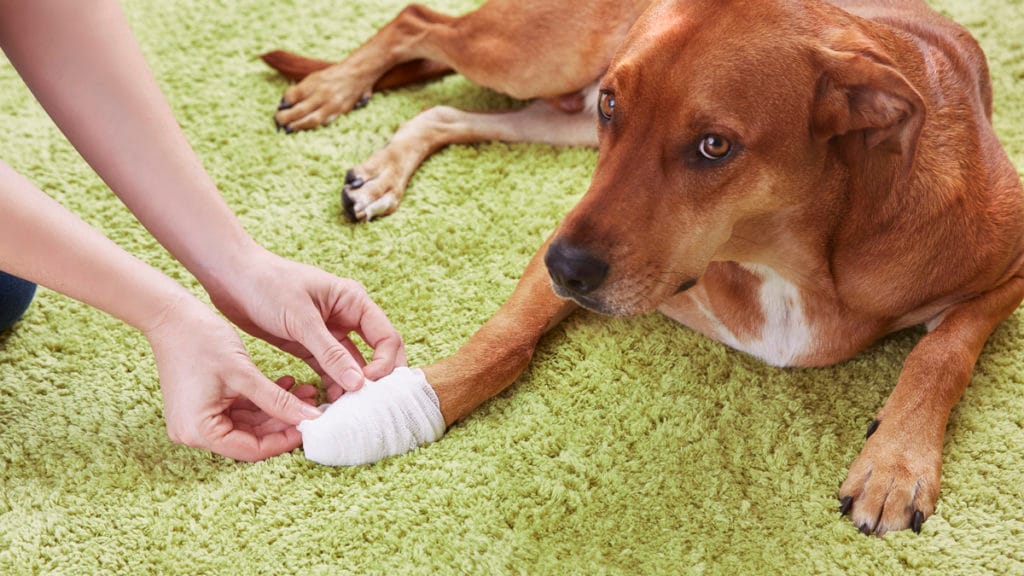No matter how much you protect and love your pet, accidents happen. By knowing the basics of animal first aid, you’ll feel less anxious about caring for an injured pet. Heather Loenser, DVM, an associate veterinarian at the Bridgewater Veterinary Hospital in New Jersey, will fill you in on the most common pet first-aid strategies just in time for Pet First Aid Awareness Month. Take a few minutes to read through them now so you’ll feel calm and confident during a pet emergency.
Put together a first-aid kit. Keep organized supplies on hand so they’ll be ready when you need them, says Loenser. Your kit should include hydrogen peroxide (it can induce vomiting if your pet eats something toxic and the emergency vet instructs you to do so), antibiotic ointment (for small wound care), bandages and wraps. Try Sentry HC Antibacterial Wound Cream for Dogs to speed healing and kill topical bacteria. Nutri-Vet Assorted Color Bitter Pet Bandages will hold dressings in place and provide added support for strains and sprains. In case your dog injures his paw, consider the Ultra Paws Disposable Dog Boot Wraps to keep his paw dry and clean, especially when playing outside.
Download an app. The Red Cross Pet First Aid App (available through Apple and Google Play) gives you step-by-step instructions and videos for 25 common pet emergencies. It also offers an animal hospital locator, which is helpful if you’re away from home. Take a few minutes to install it on your phone now, because you never know what might come up out of the blue.
Be extra gentle. When your pet is hurt, you need to take a look to see what’s going on. But keep in mind that even the sweetest animal may bite or scratch when injured, so take it slow. Also resist the temptation to hug your injured pet because it might actually scare him. If your pet is not vomiting, you can use a muzzle to avoid the chance of being bitten.
Handle minor cuts at home. If your dog or cat is bleeding from a scratch or even claws you clipped too short, apply a pinch of the Remedy & Recovery Stop Bleeding Styptic Powder along with moderate pressure. And because it’s alcohol-free, it won’t sting. Afterwards, rub on Dr. Harvey’s Healing Dog & Cat Cream. Since it’s made with organic shea butter and herbal extracts, you don’t have to stress if your pet licks it.
Know when you need the vet. “You should see the vet if a wound is more than 1 centimeter long, was caused by a bite from another animal, or is over the abdomen, the face or a joint,” says Loenser. “Many bite wounds are more serious than they appear,” she cautions. “The part you can see is often only the tip of the iceberg.” In particular, she notes that wounds over the chest or abdomen are prone to serious infections. Consult your vet’s office if your pet is limping and has vomiting or diarrhea. The office will advise you whether or not you need to come in based on other symptoms.
Keep important numbers handy. Put your vet’s phone number in the “contacts” on your phone and place the office’s business card in the first aid kit. Also consider noting two other vital numbers—the ASPCA Poison Control Hotline (888-426-4435) and the Pet Poison Helpline (855-764-7661). A veterinary toxicology specialist will be able to assist you if you think your pet ate something potentially harmful. Signs of pet poisoning include dilated pupils, drooling or foaming at the mouth, and seizures.
Learn dog CPR. Just like humans, dogs need CPR when they’ve stopped breathing or their heart has stopped beating. First, make sure an object isn’t blocking their airway. Open your dog’s mouth and pull the tongue forward to have a look. If you don’t see an obstruction, move to CPR. The American College of Veterinary Emergency and Critical Care recommends the following steps: Place your dog on his side on the floor, kneeling behind his back with your knees against his spine. Place one hand over the other and put them on top of your dog’s heart. With your elbows straight, bend at the waist to make compressions about two times per second. After every 30 compressions, give two quick breaths to your dog’s snout. A training session through the American Red Cross and even your vet’s office can provide more details, like how to locate your dog’s heart depending on the breed you have, and will give you the chance to practice on an animal mannequin.
While a pet emergency is something you’ll surely want to avoid, being prepared will help you better address the issue
Share:














